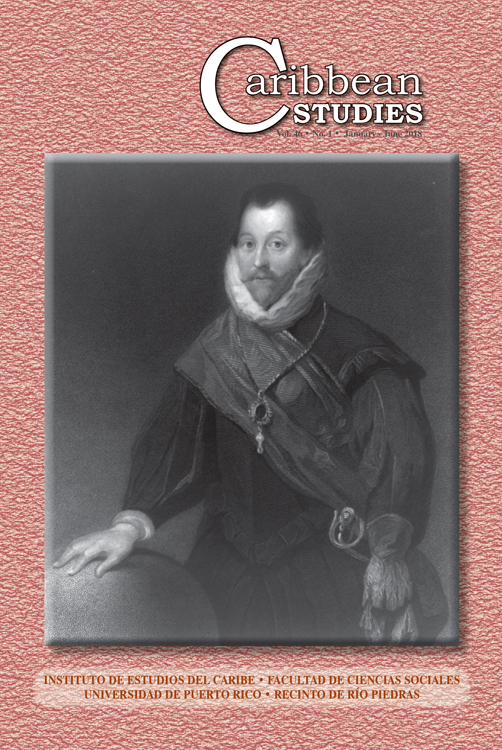Abstract
This study analyzes possible climatic connections that establish the subtropical anticyclone of the North Atlantic (NASH) between two regions of the Atlantic Ocean. The fundamental importance of NASH is widely known by the scientific community. The condition of its large center of action in the regions around the Atlantic Ocean is the key part in the general atmospheric circulation between tropics, subtropical limits and the mid-latitudes. We have used monthly measures of the atmospheric pressure of San Fernando-Cádiz (Spain), as a reference point of the Southwest area of the Iberian Peninsula, and of San Juan (Puerto Rico) and Guantánamo (Cuba), as reference points for the north of the Caribbean Sea. The analysis also includes the monthly values of the North Atlantic Oscillation (NAO) index. The climatic registers that have been used correspond to a sequence of fifty-four years between 1956 and 2009. The results of the correlations show four months of the year (February, June, August and October) with significant positive statistical values between the atmospheric pressures of San Juan-Guantánamo and San Fernando-Cádiz. They also show three months equally important between the pressures of San Juan-Guantánamo and the NAO index (January, February and March).
References
Camuffo, D., and P. H. Jones. 2002. Improved Understanding of Past Climatic Variability from Early Daily European Instrumental Sources. Dordrecht: Kluwer Academic Publishers.
Capel, J. 2000. El clima de la península ibérica. Barcelona: Ariel.
Castro, A. et al. 2011. “May the NAO Index be Used to Forecast Rain in Spain? Atmosfera 24(3):251-265.
David, R.E. et al. 1997. “The North Atlantic Subtropical Anticyclone.” Journal of Climate 10:728-744.
Esteban-Parra, M.J. et al. 1998. “Spatial and Temporal Patterns of Precipitation in Spain for the Period 1880–1992.” Int. J. Climatol 18:1557-1574.
Font Tullot, I. 2002. Climatología de España y Portugal. Salamanca: Universidad de Salamanca.
Giannini, A. et al. 2001. “Interdecadal Changes in the ENSO Teleconnection to the Caribbean Region and the North Atlantic Oscillation.” J. Climate 14:2867-2879.
Harman, J. 1987. “Mean Monthly North American Anticyclone Frequencies 1950–79. Mon. Wea. Rev. 115:2840-2848.
Hurrell, J.W. 1995. “Decadal Trends in the North Atlantic Oscillation and Relationships to Regional Temperatures and Precipitation. Science 269:676-679.
Hurrell, James & National Center for Atmospheric Research Staff, eds. Last modified August 16, 2016. “The Climate Data Guide: Hurrell North Atlantic Oscillation (NAO) Index (station-based).” .
Jones, P.D. et al. 1997. “Extension to the North Atlantic Oscillation Using Early Instrumental Pressure Observations from Gibraltar and South-West Iceland.” Int. J. Climatol 17:1433-1450.
Klein, W. H. 1957. “Principal Tracks and Mean Frequencies of Cyclones and Anticyclones in the Northern Hemisphere.” Weather Bureau Research Paper 40, 60 pp.
Lamb, H. H. 1973. “The Seasonal Progression of the General Atmospheric Circulation Affecting the North Atlantic and Europe.” University of East Anglia Research Publ. 1, 83 pp.
Li, W. et al. 2011. “Changes to the North Atlantic Subtropical High and Its Role in the Intensification of Summer Rainfall Variability in the Southeastern United States.” American Meteorological Society 24:1499-1506.
Malgren, B. et al. 1998. “El Niño-Southern Oscillation and North Atlantic Oscillation Control of Climate in Puerto Rico.” J. Climate 11:2713-2717.
Martín-Vide, J., and D. Fernández. 2001. “El índice NAO y la precipitación mensual en la España peninsular.” Investigaciones geográficas 26:41-58.
———, and J. Olcina-Cantos. 2001. Climas y tiempos de España. Madrid: Alianza.
Marshall, J. 2001. “North Atlantic Climate Variability: Phenomena, Impacts, and Mechanisms.” International Journal of Climatology 21:1863-1898.
Miyasaka, T., and H. Nakamura. 2005. “Structure and Formation Mechanisms of the Northern Hemisphere Summertime Subtropical Highs.” Journal of Climate 18:5046-5065.
Pozo-Vázquez, D. et al. 2000. “An Analysis of the Variability of the North Atlantic
Oscillation in the Time and the Frequency Domains. International Journal
of Climatology 20:1675-1692.
Rodó, X. et al. 1997. “Variations in Seasonal Rainfall in Southern Europe during
the Present Century: Relationships with the North Atlantic Oscillation and
the El Niño-Southern Oscillation.” Clim. Dyn. 13:275-284.
Rogers, J.C. 1984. “The Association between the North Atlantic Oscillation
and the Southern Oscillation in the Northern Hemisphere. Mon. Wea. Rev.
:1999-2015.
Sahsamanoglou, H.S. 1990. “A Contribution to the Study of Action Centres in
the North Atlantic. International Journal of Climatology 10(3):247-261.
Seager, R. et al. 2003. “Air–sea Interaction and Seasonal Cycle of the Subtropical
Anticyclones. J. Climate 16:1948-1966.
Sneyers, R. 1992. “On the Use of Statistical Analysis for the Objective Determination of Climatic Change. Meteorologische Zeitschrift 1:247-256
Teissereng de Bort, L. 1883. « Etude sur l’hiver de 1879–80 et recherches sur la
position des centres d’action de l’atmosphere dans les hivers anormaux. »
Bureau Central Meteor de la France, Annales, 1881(4):17-62.
Thom, H.C.S. 1966. “Some Methods of Climatological Analysis.” Technical
Report No. 81, WMO, Geneva.
Trigo, R. et al. 2002. “The North Atlantic Oscillation Influence on Europe: Climate Impacts and Associated Physical Mechanisms. J. Clim. Res. 20:9-17. van Loon, H., and J.C. Rogers. 1978. “The Seesaw in Winter Temperatures between Greenland and Northern Europe, Part 1: General description.”
Mon. Wea. Rev. 106:296-310. Wang C. 2007. “Variability of the Caribbean Low-Level Jet and Its Relations to Climate. Clim. Dyn. 29:411-422.
Wang, H. et al. 2010. “Intensification of Summer Rainfall Variability in the Southeastern United States during Recent Decades.” J. Hydrometeor
:1007-1018.
Wheeler, D., and R. García-Herrera. 2008. “Ships’ Logbooks in Climatological Research: Reflections and Prospects. Ann. N Y Acad. Sci. 1146:1-15.
Zorita, E. et al.1992. “The Atmospheric Circulation and Sea Surface Temperature in the North Atlantic Area in Winter: Their Interaction and Relevance for Iberian Precipitation.” J. Clim. 5:1097-1108.
Zishka, K.M., and P.J. Smith. 1980. “The Climatology of Cyclones and Anticyclones over North America and Surrounding Ocean Environs for January and July, 1950-77.” Mon. Wea. Rev. 108:387-401.

